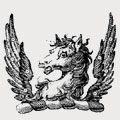The Tollemache Beer-Jugs
Price on application
YEAR OF MANUFACTURE: 1718
ORIGIN: London, England
MAKER: Augustine Courtauld
WEIGHT: 53.95 troy ounces (59.19 ounces or 1,678.00 grams)
Featured Crests

Item Description
Each baluster and on spreading stepped foot, with scroll handle and short spout, engraved with a coat-of-arms within the motto of the Order of the Thistle all below an earl's coronet, marked underneath, further engraved with scratchweights '33=16' and '27=16'
6 7/8 in. (17.5 cm.) high
53 oz. 19 dwt. (1,678 gr.)
Provenance:
Lionel Tollemache, 4th Earl Dysart K.T. (1708-1770), then by descent to
Bentley Lyonel John Tollemache, 3rd Baron Tollemache (1883-1955)
The Trustees of the Tollemache Estates; Christie's, London, 13 May 1953, lot 78 (£920 to How).
Presumably acquired from How of Edinburgh by Sir Stephen Courtauld K.T. (1883-1967), three times great grandson of Augustine Courtauld, given to his nephew in the 1960s
Colin Kenneth Dowman (1920-2010), son of Sir Stephen’s sister Catherine (1878-1972) and her husband Wilfred Harry Dowman (1879-1936), owner of the celebrated tea clipper ‘Cutty Sark’ which was donated to the nation by his widow, and then by descent to Augustine Courtauld’s five times great granddaughter.
The coat-of-arms are those of Tollemache impaling Carteret for Lionel, 4th Earl Dysart K.T. (1708-1770) and his wife Lady Grace Carteret (1713-1755), daughter of 1st Earl Granville, whom he married in 1729. He was made a Knight of the Thistle in 1743.
Artist Biography:
Augustine Courtauld (1685/6-1751)
Augustine Courtauld’s family came to England from France as part of the late 17th century Huguenot exodus. Helen Clifford, in her entry on Courtauld family in The Oxford Dictionary of National Biography, 2004, disproves the traditional tale that he was brought to England by his father as an infant in 1687, concealed in a basket of vegetables. She notes that in reality he remained in France with his grandfather and made the journey almost ten years later. Augustine’s father, also Augustine (1655-1706), was a merchant from St. Pierre in the Île d'Oléron near La Rochelle. He established himself in London and was an active member of the Huguenot community. He secured a potentially prosperous future for his son by apprenticing him to a fellow Huguenot, the goldsmith Simon Pantin, to whom Augustine junior’s half-brother Peter (1689/90–1729) was also apprenticed. Augustine senior died before either son was granted the freedom of the Goldsmiths’ Company, however he was the patriarch of a silversmithing family which went on to include of Augustine junior’s son Samuel (1720–1765) and Samuel’s wife Louisa who managed the business after his early death at the age of forty-five. Their son, Samuel Courtauld II (1752–1821), also followed his father into the trade.
Another of Samuel II and Louisa’s sons, George, was apprenticed to a silk weaver and was the founder of the business which eventually became Courtaulds PLC, now part of Akzo Nobel, whose substantial collection of silver by the Courtauld family is exhibited at the Courtauld Institute in London, much of which was the subject of a privately printed catalogue (Some silver wrought by the Courtauld family of silversmiths, Oxford, 1940), by Ernest Alfred Jones and the art collector and philanthropist Samuel Courtauld, brother of Sir Stephen Courtauld (see above). The collection has been recently redisplayed and a new catalogue published – H. Braham, A Century of Silver, The Courtauld Family of Silversmiths, 1710-1780, London, 2014.
Under the tutelage of his master, Augustine Courtauld perfected the art of crafting pieces of characteristically heavy gauge and fine quality. Much of this work was smaller domestic pieces perhaps in contrast to the commissions for large decorative pieces executed by fellow Huguenot silversmiths such as David Willaume, Paul de Lamerie and Pierre Harache. He produced many fine two-handled cups, vessels for tea, coffee and chocolate and decoratively bordered trays and salvers. Amongst the small number of highly ambitious works was a silver table, constituent part of toilets services and a centrepiece made for the Russian court. He made a comfortable living, so much so that he was able to invest in the East India Company, accumulate property and sit for a portrait by the Swedish born painter and follower of Michael Dahl Hans Hysing (1678–1753).

OFFERED BY:
Koopman Rare Art
12 Dover Street, Mayfair, London, W1S 4LL, United Kingdom View map
 Show this exhibitor's phone number
Show this exhibitor's phone number
 View all of this exhibitor's items
View all of this exhibitor's items
Price on application